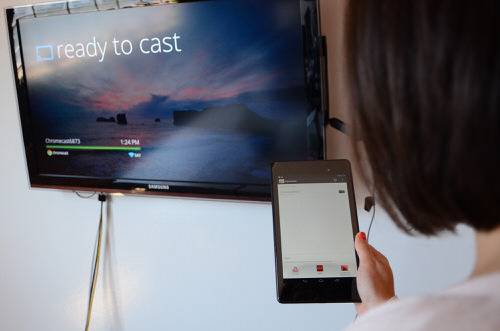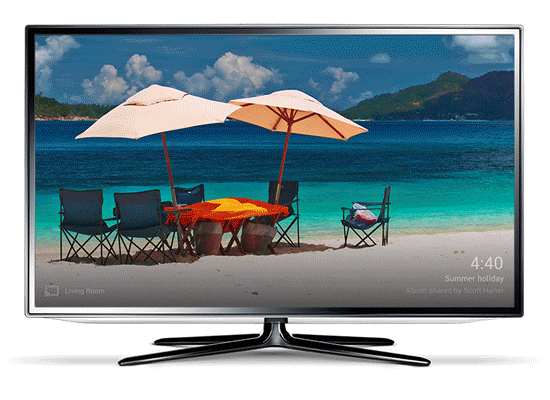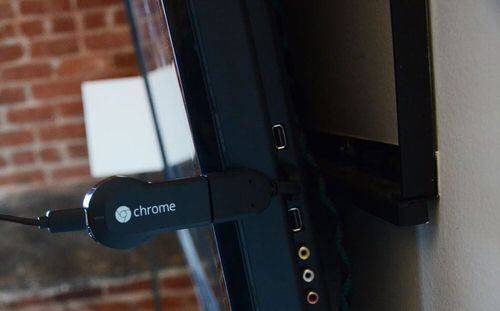
Just because Google’s new Nexus Player will offer Chromecast features, that doesn’t mean it will replace the $35 TV streaming dongle. The product’s definitely not doomed; in fact, it’s continuing to evolve. Well, at least in some ways.
There’s good news and bad news on the hardware front: Google confirmed that a new version of the Chromecast TV stick is in the works. Unfortunately, it won’t be any different from the old one. But if we get past that disappointment, there may be software changes that make up for the hardware stasis: At GigaOm’s Structure Connect event this week, Google’s Mario Queiroz, vice president of product management, said developers may get access to its new Backdrop feature.
See also: Google Unveils New Nexus Devices, A Media Player And Android 5.0 Lollipop
In other words, app makers may soon have a major new way to reach users—by taking over the default, standby mode of the biggest screen in their homes.
Forget Chromecast v.2. Backdrop’s Stepping Forward
Last week, a second-generation Chromecast popped up in a recent filing with the Federal Communications Commission. Tongues wagged. Fan anticipation grew. Then during a fireside chat on the GigaOm stage on Tuesday, Google’s Queiroz sealed the deal, confirming that a new version of Chromecast was in the works.
Too bad it’s rather disappointing when you dig into the details. Although Queiroz wouldn’t talk specifics, a person familiar with Google’s plans told ReadWrite that the device update won’t involve any new hardware. “This new [FCC] filing is about updating manufacturing numbers,” said our source. “It’s not a new product. It won’t really be any different than the first-generation TV stick.”
See also: Google’s Chromecast Can Now Beam Art And Your Photos To Your TV
But that’s not all Queiroz talked about. He also said that Google is considering a new Backdrop API for third-party developers. (See our API explainer.)
Earlier this month, the company launched Backdrop, a new feature sort of like a smart screen saver: It displays your personal photos, professional artwork and headline news whenever you’re not actively “casting,” or streaming to your TV from your phone.

Currently, the only part of Backdrop that you can customize is your Google Plus photo collection. (The art and news sources are pre-selected by Google.) But if developers support it, they could presumably give people more choices. Think sports scores, daily appointments or shared calendars, stock tickers and Twitter feeds crawling the TV screen by default, in between streams.
That’s just the beginning. Imagine a virtual Pinterest pinboard taking physical form in your living room. Or for people like my parents, they could see their grandkids’ pictures display on the TV without having to launch an app and cast them.
The pace of Chromecast development has been ramping up lately. Another feature announced at Google I/O last June, alongside Backdrop, was ultrasonic pairing, a convenience feature that lets pals join a casting session without hopping on your Wi-Fi network. At this point, its still pending, but at least that gives Chromecast users more to look forward to.
Chromecast Is Just Getting Started

Chromecast has been a hit since it debuted in July 2013. It quickly ruled Amazon’s best-selling electronics list, and has remained there almost constantly—beating out even the site’s own products—for more than a year.
Its charm comes down to a simple concept: By adding a $35 device, anyone with a TV and smartphone can use the gear they already own to enjoy streaming media on the big screen. And Google Cast—the technology that powers the casting action—makes it easy to use.
It’s so easy, in fact, that usage appears to be rocketing upward. According to Queiroz, people have flung media to their Chromecast-connected televisions 650 million times. And, he said, more than a third of those cast sessions took place over the last three months.
In February, the company released the Google Cast software development kit (SDK), and now hundreds of apps support Chromecast casting, he said—which is a far cry from the four sources the device initially offered. Now it’s set to grow even more. More than 6,000 developers are now working on creating more than 10,000 apps, he added.
“We’re building an eco-system of applications which are Google Cast–ready, and end points which are Google Cast–ready,” he said. Those “end points” are devices like the new Nexus Player, which will offer casting features out of the box. (That is, assuming there aren’t any more hiccups from the FCC.)
As for the Chromecast itself, even though it won’t be getting any hardware upgrades anytime soon, its development hasn’t stagnated. On the contrary, the little TV stick appears to be growing up.
Chromecast Backdrop animated GIF image courtesy of Google. All others by ReadWrite










